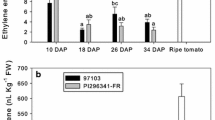Abstract
Phosphoenolpyruvate carboxykinase (PEPCK) is present in ripening tomato fruits. A cDNA encoding PEPCK was identified from a PCR-based screen of a cDNA library from ripe tomato fruit. The sequence of the tomato PEPCK cDNA and a cloned portion of the genomic DNA shows that the complete cDNA sequence contains an open reading frame encoding a peptide of 662 amino acid residues in length and predicts a polypeptide with a molecular mass of 73.5 kDa, which corresponds to that detected by western blotting. Only one PEPCK gene was identified in the tomato genome. PEPCK is shown to be present in the pericarp of ripening tomato fruits by activity measurements, western blotting and mRNA analysis. PEPCK abundance and activity both increased during fruit ripening, from an undetectable amount in immature green fruit to a high amount in ripening fruit. PEPCK mRNA, protein and activity were also detected in germinating seeds and, in lower amounts, in roots and stems of tomato. The possible role of PEPCK in the pericarp of tomato fruit during ripening is discussed.
Similar content being viewed by others
References
Altschul, S.F., Madden, T.L., Schaffer, A.A., Zhang, J., Zhang, Z., Miller, W. and Lipman, D.J. 1997. Gapped BLAST and PSI-BLAST: a new generation of protein database search programs. Nucl. Acids Res. 25: 3389–3402.
Bahrami, A.R. and Gray, J.E. 1999. Expression of a proteasome α-type subunit gene during tobacco development and senescence. Plant Mol. Biol. 39: 325–333.
Blanke, M.M., Hucklesby, D.P. and Notton, B.A. 1988 Phos-phoenolpyruvate carboxykinase in aubergine, kiwi and apple fruit. Gartenbauwissenschaft 53: 65–70.
Chomczynski, P. and Sacchi, N. 1987. Single-step method of RNA isolation by acid guanidinium thiocyanate-phenol-chloroform extraction. Anal. Biochem. 162: 156–159.
Farineau, J. and Laval-Martin, D. 1977. Light versus dark metabolism in cherry tomato fruits. II. Relationship between malate metabolism and photosynthetic activity. Plant Physiol. 60: 877–880.
Finnegan, P.M. and Burnell, J.N. 1995. Isolation and sequence analysis of cDNAs encoding phosphoenolpyruvate carboxyki-nase from the PCK-type C4 grass Urochloa panicoides.Plant Mol. Biol. 27: 365–376.
Finnegan, P.M., Suzuki, S., Ludwig, M. and Burnell, J.N. 1999. Phosphoenolpyruvate carboxykinase in the C4 monocot Urochloa panicoides is encoded by four differentially expressed genes. Plant Physiol. 120: 1033–1041.
Goodenough, P.W., Prosser, I.M. and Young, K. 1985. NADP-linked malic enzyme and malate metabolism in ageing tomato fruit. Phytochemistry 24: 1157–1162.
Halford, N.G. and Hardie, D.G. 1998, SNF1-related protein kinases: global regulators of carbon metabolism in plants? Plant Mol. Biol. 37: 735–748.
Halinska, A. and Frenkel, C. 1991. Acetaldehyde stimulation of net gluconeogenic carbon movement from applied malic acid in tomato fruit pericarp tissue. Plant Physiol. 95: 954–960.
Hawker, J.S. 1969. Changes in the activities of malic enzyme, malate dehydrogenase, phosphopyruvate carboxylase and pyru-vate decarboxylase during the development of a non-climacteric fruit (the grape). Phytochemistry. 8: 19–23.
Hobson, G.E. and Davies, J.N. 1971. The tomato. In: A.C. Hulme (Ed.) The Biochemistry of Fruits and their Products. Academic Press, London, pp. 437–482.
Knee, M. and Finger, F.L. 1992. NADP+-malic enzyme and organic acid levels in developing tomato fruits. J. Am. Soc. Hort. Sci. 117: 799–801.
Langdale, J.A., Rothermel, B.A. and Nelson, T. 1988. Cellular patterns of photosynthetic gene expression in developing maize leaves. Genes Dev. 2: 106–115.
Leegood, R.C. and Walker, R.P. 1999. Phosphoenolpyruvate car-boxykinase: iIts role and regulation. In: J.A. Bryant, M.M. Burrell and N.J. Kruger (Eds.) Plant Carbohydrate Biochemistry Bios Scientific Publishers, Oxford, pp. 201–213.
Murata, T., Ohsugi, R., Matsuoka, M. and Nakamoto, H. 1989. Purification and characterization of NAD malic enzyme from leaves of Eleusine coracana and Panicum dichotomiflorum.Plant Physiol. 89: 316–324.
Ruffner, H.P. 1982a. Metabolism of tartaric and malic acids in Vitis: a review ¶ Part A. Vitis 21: 247–259.
Ruffner, H.P. 1982b. Metabolism of tartaric and malic acids in Vitis: a review ¶ Part B. Vitis 21: 346–358.
Ruffner, H.P. and Kliewer, W.M. 1975. Phosphoenolpyruvate car-boxykinase activity in grape berries. Plant Physiol. 56: 67–71.
Ruffner, H.P. and Hawker, J.S. 1977. Control of glycolysis in ripening berries of Vitis vinifera. Phytochemistry 16: 1171–1175.
Ruffner, H.P., Possner, D., Brem, S. and Rast, D.M. 1984. The physiological role of malic enzyme in grape ripening. Planta 160: 444–448.
Sáez-Vásquez, J., Raynal, M. and Delseny, M. 1995. A rape-seed cold-inducible transcript encodes a phospohoenolpyruvate carboxykinase. Plant Physiol. 109: 611–618.
Sambrook, J., Fritsch, E. F. and Maniatis, T. 1989. Molecular Ccloning: A Laboratory Manual, 2nd ed. Cold Spring Harbor Laboratory Press, Plainview, NY.
Seymour, G.B., Taylor, J.E. and Tucker, G.A. 1993. Biochemistry of Fruit Ripening. Chapman and Hall, London.
Walker, R.P. and Leegood, R.C. 1996. Phosphorylation of phos-phoenolpyruvate carboxykinase in plants: studies in plants with C4 photosynthesis and Crassulacean acid metabolism and in germinating seeds. Biochem. J. 317: 653–658.
Walker, R.P., Trevanion, S.J. and Leegood, R.C. 1995. Phos-phoenolpyruvate carboxykinase from higher plants: purification from cucumber and evidence of rapid proteolytic cleavage in extracts from a range of plant tissues. Planta 196: 58–63.
Walker, R.P., Acheson, R.M., Técsi, L.I. and Leegood, R.C. 1997. Phosphoenolpyruvate carboxykinase in C 4 plants: its role and regulation. Aust. J. Plant Physiol. 24: 459–468.
Author information
Authors and Affiliations
Rights and permissions
About this article
Cite this article
Bahrami, A.R., Chen, ZH., Walker, R.P. et al. Ripening-related occurrence of phosphoenolpyruvate carboxykinase in tomato fruit. Plant Mol Biol 47, 499–506 (2001). https://doi.org/10.1023/A:1011842828723
Issue Date:
DOI: https://doi.org/10.1023/A:1011842828723




